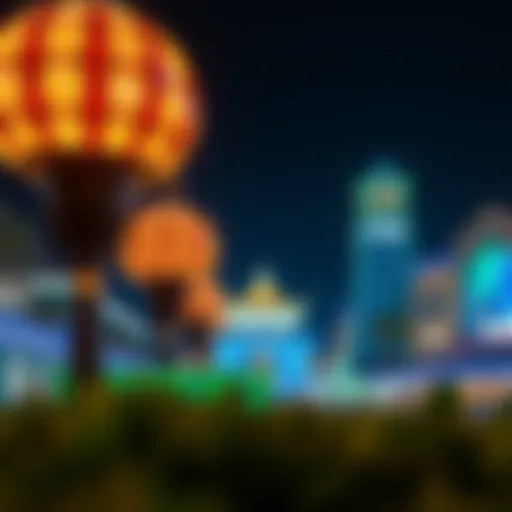UAE Interior Design Companies: Trends and Insights
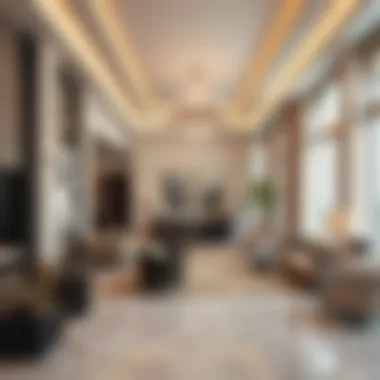

Intro
The interior design scene in the United Arab Emirates has surged over the last couple of decades, largely shaped by the region's unique blend of cultural heritage and modern aspirations. With cities like Dubai and Abu Dhabi burgeoning into global hotspots for tourism and finance, the role of interior designers has evolved beyond mere aesthetics; they are now strategic partners in bringing luxury and function to residential and commercial spaces alike.
In this article, we will explore the multifaceted landscape of interior design companies in the UAE, considering how various influences—ranging from cultural contexts to global trends—affect the industry. We’ll dive into market insights, providing clarity on current trends within the Dubai real estate sector, and address the price fluctuations that impact both buyers and investors. By offering a lens into reputable firms and emerging trends, we aim to inform potential clients about the valuable services these companies provide in enhancing the real estate ventures in the UAE.
The journey through this discourse opens doors for investors, homebuyers, realtors, expatriates, and developers, unveiling the depth of creativity and innovation nestled within the walls of UAE’s interior design firms.
Intro to UAE Interior Design
The interior design landscape in the United Arab Emirates is not just about aesthetics; it's a reflection of a dynamic cultural tapestry and a rapidly growing economy. With each skyscraper that pierces the skyline of cities like Dubai and Abu Dhabi, there’s a story woven into the fabric of its interiors. For potential investors, homebuyers, and even expatriates searching for a place to call home, understanding the nuances of UAE interior design becomes essential.
One notable fact is the significant role that interior design plays in the overall real estate market in the UAE. Properties adorned with thoughtful design often fetch higher market prices and attract potential buyers more swiftly than those that are not. Interior design isn’t merely about what looks good on the surface; it’s about how spaces function and how occupants feel within them. This sector, therefore, has implications that transcend aesthetics, touching upon emotional well-being and productivity.
Several factors contribute to the unique character of interiors in this region. The blend of traditional Middle Eastern designs with contemporary influences creates spaces that are distinctive and inviting. For instance, one might encounter intricate mashrabiya woodwork paired with modern, minimalist furniture. These layers of design help buyers envision a lifestyle that is both rooted in culture and progressive.
Beyond just personal taste, there are also practical considerations such as environmental factors and local customs that shape design choices. Climate considerations – with temperatures often reaching peaks – lead to designs emphasizing air circulation and shade. Additionally, the social dynamics in the UAE require homes to be conducive for gatherings, which can affect layout and design choices.
In sum, the importance of understanding UAE interior design cannot be overstated. For those looking to invest or make a home in this region, grasping these unique design principles offers not just insight but facilitates smarter choices in real estate ventures. As we navigate through this article, we will dissect the multifaceted elements of this thriving sector, shedding light on the historical context, current trends, and the remarkable companies that contribute to this ever-evolving landscape.
Historical Context of Interior Design in the UAE
The evolution of interior design in the UAE offers a rich tapestry that weaves together tradition, modernity, and cultural shifts. Understanding this historical context is crucial for appreciating how present-day aesthetics and functionalities shape the interior landscape. The UAE’s journey in this domain reflects not only the region’s unique identity but also its rapid transformation in a globalized world.
Historically, the interior designs found in traditional Emirati homes were characterized by simplicity and functionality. Early structures often featured mud-brick walls and wooden beams, with layouts designed for a nomadic lifestyle. For example, the majlis—a gathering room central to Emirati culture—was often adorned with intricate textiles and carpets, fostering community and hospitality. Such spaces were essential, acting as both living areas and venues for social interaction.
As oil was discovered in the late 20th century, the UAE experienced a surge in wealth and development. The resulting urbanization brought a wave of architectural innovation, integrating modern materials and design philosophies. Cities like Dubai and Abu Dhabi transitioned from modest settlements to sprawling metropolises, dramatically altering design approaches. This transformation compelled interior designers to reimagine spaces, creating luxurious environments that reflect both local and international influences.
Key Historical Elements:
- Cultural Fusion: UAE's interior design has evolved to blend traditional Arab elements with international styles. As new residents and tourists from diverse backgrounds arrived, so too did an inflow of different design philosophies. This fusion is prominently seen in hospitality venues in Dubai, where opulent grand lobbies echo global trends while retaining local motifs.
- Architectural Innovativeness: The rise of skyscrapers and avant-garde building designs has facilitated new opportunities for interior design firms. They have adapted to create high-end interiors in commercial spaces, drawing from contemporary materials yet respecting regional aesthetics.
- Historical Preservation: As a counterbalance to rapid modernization, there has been a conscious effort to preserve cultural heritage in interior design. Firms often integrate elements from traditional designs in modern projects, reinforcing a narrative that values the past while embracing the future.
"In many ways, the UAE's interior design scene reflects its identity—a blend of tradition meeting modernity, tailored for a global audience."
The significance of the historical context of interior design in the UAE lies in its ability to highlight how far the region has come while providing insight into its future direction. The balance between heritage and modernity serves as a cornerstone for both designers and clients, ensuring that projects resonate on a deeper cultural level.
Through the lens of history, we can better appreciate the dynamic practices and styles brought forth by today's UAE interior design companies, leading to a seamless fusion that captures the essence of this unique region.
Key Influences on Interior Design Trends
The landscape of interior design in the UAE is a tapestry woven with threads of various influences. Understanding these influences is crucial for anyone seeking to engage with interior design companies in the region. They not only shape aesthetic preferences but also reflect the cultural, social, and technological milieu unique to this vibrant market. Here, we discuss the key influences driving interior design trends.
Cultural Heritage and Modern Interpretation
The UAE’s interior design scene is firmly rooted in its rich cultural heritage. This heritage manifests in designs that reflect traditional Arabic architecture, textiles, and motifs, but with a contemporary twist. Houses adorned with intricate mashrabiya screens or majlis areas designed for communal gatherings showcase this blend well. The interplay between the old and new creates a visual narrative that honors the past while embracing modernity.
Designers often draw inspiration from historical Islamic art, incorporating geometric patterns and calligraphy, translating them into a style that resonates with today’s inhabitants. This balance is not just about aesthetics; it carries deep meaning, knitting together the stories of the local populace with global influences.
- Example: A living room that features plush sofas in bold colors and geometric patterns alongside authentic Arabic lanterns is a prime example of this blend.
The challenge for designers is to ensure that while they dabble in modern trends, the essence of cultural identity remains intact. This not only serves to attract discerning clients but also educates a broader audience about the depth of UAE culture and its contributions to global design.
Globalization’s Impact on Design Choices
In today’s interconnected world, globalization has a profound impact on interior design practices in the UAE. The influx of expatriates from various backgrounds has diversified the market, leading to a melting pot of design ideas. Clients these days often seek a blend of international styles along with local flavors, resulting in unique fusions that are fresh and exciting.
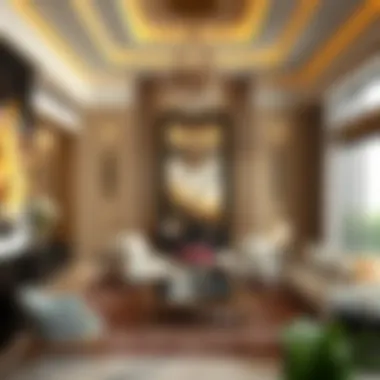

Design companies in the UAE are now tasked with incorporating global trends into their offerings while retaining a distinct local character. This can mean using internationally sourced materials or integrating styles from different parts of the world—be it minimalist aesthetics from Scandinavia or the bold color palettes typical of Indian design.
Some notable trends influenced by globalization include:
- Open floor plans that embrace the concept of spaciousness
- Eco-friendly and sustainable practices that echo worldwide concerns
- Use of cutting-edge furniture and art from international designers
While this diversity enriches the design landscape, it also presents challenges. As tastes evolve, designers must stay ahead of the curve, continually refreshing their portfolios to include contemporary styles that resonate with a global audience without losing sight of local significance.
Technological Advancements in Design Processes
Technological innovation has revolutionized several sectors, and interior design is no exception. In the UAE, companies are leveraging advanced design software and online platforms to enhance their services. 3D modeling, virtual reality walkthroughs, and online consultation tools have transformed the way clients experience design.
The digital ecosystem allows for:
- Real-time collaboration that speeds up the design process
- Customization options for clients looking for personalized experiences
- Sustainability tracking through software that calculates resource use
These advancements not only streamline workflow but significantly improve client engagement. For instance, virtual reality experiences enable clients to visualize their spaces before implementation, providing a clearer sense of what to expect.
However, as impressive as these tools are, they require designers to possess a skill set that is increasingly tech-savvy. The ability to wield technology effectively becomes a differentiator in the competitive UAE market, making it imperative for firms to continuously update their technological capability and training.
"In the world of interior design, adaptability is a designer's best friend."
Types of Interior Design Services Offered
In the realm of interior design, understanding the varied types of services offered is essential for making informed decisions. Each category caters to diverse needs, providing tailored solutions for distinct environments. Whether enhancing a home, creating an inviting commercial space, or ensuring a luxurious hospitality experience, the right service can significantly impact aesthetics, functionality, and even brand identity. By knowing the types of services available, clients can select what aligns best with their visions and operational requirements.
Residential Interior Design
Residential interior design focuses on creating spaces that reflect personal style while also maximizing comfort and functionality. This type of design considers both the emotional and practical needs of the inhabitants. For instance, in an upscale villa in Dubai, one might witness the incorporation of traditional Emirati elements with modern designs. This allows for a warm, welcoming atmosphere that resonates with cultural pride.
The process typically starts with understanding the client's lifestyle and preferences. Designers might use color schemes, furniture layouts, and lighting choices to create a harmonious environment.
Key benefits include:
- Personalized Approach: Tailoring designs to suit individual tastes.
- Functional Spaces: Ensuring each room serves its intended purpose efficiently.
- Emotionally Inviting: Creating a nurturing living environment that feels like home.
As homeowners in the UAE often invest significantly in their property, effective residential design translates into both enhanced living quality and higher property values.
Commercial Interior Design
When it comes to commercial spaces, interior design takes on a different approach. This type of design seeks not only to represent the brand image but also to boost productivity and comfort for employees and clients alike. In a bustling city like Abu Dhabi, well-designed office spaces can set a business apart.
The strategy usually involves understanding the functionality required within the space— be it an office, retail shop, or co-working area.
Benefits of commercial design include:
- Brand Identity: Harmonizing the design with the company’s branding strategy.
- Employee Productivity: Crafting environments that foster collaboration and efficiency.
- Customer Appeal: Creating inviting spaces that encourage client interaction.
With the emirate's ongoing economic growth, commercial interior design is pivotal in helping companies attract and retain talent while providing a conducive atmosphere that reflects the brand’s ethos.
Hospitality Interior Design
Hospitality interior design marries functionality with appeal, creating memorable experiences in spaces such as hotels, restaurants, and resorts. In a tourism hub like Dubai, where luxury is often the selling point, this type of design plays a crucial role. Designers must balance aesthetics with functionality to ensure guests have a flawless experience.
Important considerations often involve:
- Cohesive Themes: Developing a unique theme that can create narrative experiences for guests.
- Comfort and Luxury: Utilizing materials and layouts that provide comfort while upholding sophisticated standards.
- Feedback Integration: Adjusting spaces based on guest experiences to continually elevate the service.
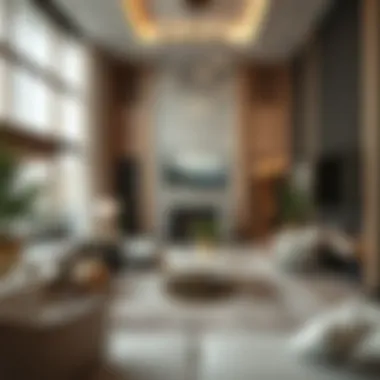

The ultimate goal here revolves around attracting visitors and ensuring they have an unforgettable stay; a well-designed hospitality space encourages repeat visits, contributing to the revenue and reputation of businesses in the sector.
Prominent Interior Design Companies in the UAE
When talking about the field of interior design in the UAE, the significance of identifying the prominent companies cannot be understated. These firms are rightly viewed as the beacons of design excellence, shaping not only the architectural aesthetic but also the very ambiance of living and working spaces across the nation. Not only do they contribute to the local economy, but they also act as cultural ambassadors, reflecting the melting pot of traditional and modern influences that define the UAE’s design ethos.
Noteworthy companies in this landscape carry a reputation for blending innovative practices with a deep respect for the environment and local heritage. Therefore, understanding who these players are—and what they bring to the table—can be invaluable for potential investors, homebuyers, realtors, expatriates, and developers looking to navigate the intricate web of services offered in this vibrant sector.
Top Firms to Consider
The UAE is home to a plethora of interior design firms that range from established names to fresh faces quietly making waves. Here are some of the top players that are worth keeping an eye on:
- MADD Creative: Known for its stunning modern aesthetics, MADD merges functionality with creativity, ensuring that each space crafted is a visual treat. From residential to commercial spaces, their approach encompasses a variety of styles, focusing heavily on customization to meet client needs.
- KCA International: With over two decades in the UAE, KCA is celebrated for its luxury designs. Their expertise rooted in understanding client preferences leads to one-of-a-kind interiors that continue to dazzle. Whether it revolves around a lavish villa or a chic hospitality environment, their projects exemplify luxury.
- Bishop Design: This firm emphasizes not just the aesthetics but also the emotional experience of spaces. Bishop Design utilizes sustainable materials, aligning with the growing demand for eco-conscious designs—a significant consideration in today’s world.
Key Considerations
When contracting with these firms, it’s essential to understand their design philosophies, previous projects, and client testimonials. Factors like understanding local regulations, timelines, and budget constraints should be pivotal in the decision-making process. Engaging with the firms through consultations can provide insight into how well they align with the specific visions clients may wish to bring to life.
Emerging Players in the Market
As the UAE continues to grow, so too does its interior design landscape, giving way to emerging companies that often bring fresh perspectives and innovative approaches. These firms may not have the immense legacy of their more established counterparts, but they present unique offerings that cater to evolving trends and consumer preferences.
- Rashid Al-Sharafi Design: A newer firm gaining prominence, Rashid Al-Sharafi Design prides itself on culturally-sensitive designs that incorporate local aesthetics with modern elements. Their work speaks volumes about narrowing the gap between heritage and progress.
- Sculpt Design: This studio has been creating buzz with its eco-friendly practices. Sculpt Design emphasizes sustainable interiors while fostering an artistic flair, ensuring beauty does not compromise environmental ethics.
Adopting a project-oriented approach, these firms often prioritize collaborative efforts with clients, making it easier to realize individual design visions. This detail-oriented methodology can offer personalized and satisfactory outcomes for a diverse clientele.
In a nutshell, whether it's the prominent firms setting the bar high or the emerging players bringing renewed energy to the field, each contributes crucially to the complex tapestry of UAE interior design. This ever-evolving industry not only stands as a testament to creative vision but also illustrates how local firms can help elevate global standards.
Sustainable Design Practices in the UAE
The importance of sustainable design practices in the UAE cannot be overstated as the region navigates its rapid urban growth while facing pressing environmental challenges. In a country synonymous with innovation and luxury, the movement towards more sustainable interior design is gaining traction and presents numerous opportunities for enhancing both aesthetic appeal and functionality. By integrating eco-friendly practices into the design process, interior designers not only contribute to environmental conservation but also cater to a sector of consumers increasingly aware of their ecological footprints.
The Role of Eco-Friendly Materials
When it comes to sustainable design, the choice of materials plays a pivotal role. In the UAE, designers are embracing materials that not only reduce environmental impact but also provide durability and style.
- Recyclable Products: Many interior design companies are sourcing materials that can be recycled at the end of their life cycle, dramatically reducing waste in landfills.
- Locally Sourced Materials: By using materials sourced within the region, companies can significantly reduce transportation emissions, thus promoting local economies.
- Natural Materials: Biodegradable materials like bamboo, cork, and reclaimed wood offer fantastic options that are both beautiful and sustainable. They lend a unique character to spaces and reduce the reliance on synthetic products that can pollute.
Ultimately, eco-friendly materials not only enhance the environmental profile of a project, but they can also engage clients who seek to make a statement about their values through their choice of space.
Importance of Energy Efficiency
Energy efficiency in interior design is another cornerstone of sustainable practices. It goes beyond just the structural factor; how spaces are utilized can drastically affect energy consumption. Here are a few key aspects worth considering:
- Smart Technologies: The integration of smart home technologies allows for dynamic control of lighting, heating, and cooling. These systems adapt to user habits and can cut energy costs significantly.
- Insulation Standards: Properly designed interiors with enhanced insulation are crucial in minimizing energy loss, which is particularly valuable in the UAE’s harsh climate. A well-insulated building can maintain comfortable temperatures without excessive heating or cooling.
- Natural Lighting: Designing spaces to maximize natural light not only brightens an area but also reduces reliance on artificial lighting during daylight hours, leading to lower energy expenditure.
By focusing on energy efficiency, companies can further their commitment to sustainability, providing quantifiable benefits to clients in terms of reduced operational costs.
Implementing sustainable design practices in the UAE is more than just a trend; it is a necessary evolution in the face of growing environmental concerns. The integration of eco-friendly materials and a focus on energy efficiency not only enhances the quality of life for inhabitants but also positions businesses as leaders in a rapidly changing market attentive to the needs of the planet.
Challenges Facing Interior Design Companies
In the vibrant world of interior design within the UAE, companies are not just tasked with creating visually stunning spaces; they must also navigate a complex landscape filled with challenges. These hurdles can seriously break a design firm’s stride, hindering growth and innovation. Understanding these challenges is crucial for anyone involved in the real estate or design industry – be it investors, homebuyers, realtors, expatriates, or developers. By recognizing these difficulties, all parties can better appreciate the dynamics at play and make more informed decisions.
Regulatory Hurdles and Compliance
The interior design world in the UAE is laden with regulations that firms must adhere to. The government enforces strict building codes and safety standards, aiming to protect public welfare and ensure quality in construction. For instance, these codes may cover everything from how materials must be sourced, to specifications for electrical wiring and fire safety systems. For newcomers to the industry, understanding these myriad requirements can feel like deciphering a complex legal labyrinth.
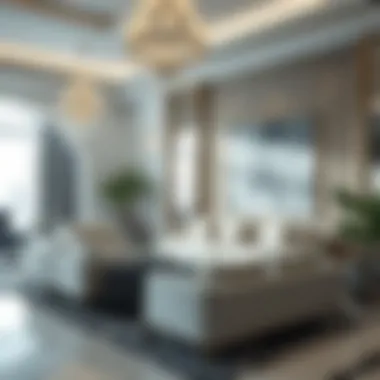

"Staying compliant not only avoids heavy fines but also fosters trust with clients and stakeholders," says Saif Al-Mansoori, a seasoned interior designer based in Dubai. The stakes are high; failure to comply with these laws can result in project delays or even cancellations, which can tarnish a company’s reputation.
In addition, as the UAE continues to modernize and globalize, new regulations are frequently introduced. Firms must remain perpetually alert to evolving rules, requiring them to invest time and resources in paperwork and legal advice. This dynamic adds an additional layer of stress, particularly for smaller companies that may not have the budget to hire dedicated compliance specialists.
Adapting to Changing Client Expectations
In today’s fast-paced world, client expectations are shifting like sands in the Dubai desert. Modern clients are not just looking for aesthetic appeal; they want functionality, sustainability, and a reflection of their personal brand. This means interior design companies need to stay ahead of trends and understand cultural nuances that may influence preferences.
For instance, with the increasing awareness of sustainability, many clients prefer to collaborate with firms that prioritize eco-friendly practices. This could mean opting for locally sourced materials or choosing designs that enhance energy efficiency. Interior design companies must now be ready to incorporate these values into their proposals, often requiring substantial research and development of new strategies.
Moreover, the use of technology has become a game changer. Clients expect virtual reality walk-throughs, 3D models, and other digital tools before they ever sign off on designs. Firms must invest in cutting-edge technology and continuously train their teams to meet these high expectations, resulting in increased operating costs.
Understanding these challenges not only equips companies to handle them strategically but also sheds light on the resilience and creativity of the UAE’s interior design companies. By adapting to regulatory pressures and evolving client demands, these firms can carve out a niche that doesn’t merely weather the storm but thrives within it.
The Future of Interior Design in the UAE
The future of interior design in the UAE is a subject that resonates deeply with investors, homebuyers, realtors, expatriates, and developers. As the region grows, it is crucial to examine what lies ahead for interior design, as it will undoubtedly influence the real estate market and cultural landscape. The increasing demand for multifaceted and innovative spaces underscores the importance of addressing emerging trends and technologies in the interior design realm.
The local market is not just about moving from one trend to the next; it’s about establishing a unique identity that encapsulates both traditional influences and modern complexities. By understanding the future trajectory of this field, stakeholders can navigate their projects with an informed perspective, ensuring that they create spaces that do more than just please the eye—they must also resonate on a deeper, functional level.
Trends to Watch
As we look ahead, several trends are poised to shape the interior design landscape in the UAE. Here are a few that demand attention:
- Sustainability: Fueled by global awareness of environmental issues, the trend toward eco-friendly materials and energy-efficient designs is gaining momentum. Consumers are now asking for interiors that align with their values—such as using sustainable materials like reclaimed wood or low-VOC paints.
- Cultural Fusion: As Dubai and Abu Dhabi attract diverse populations, designers are leaning into this melting pot of cultures. Expect to see more designs that combine traditional Middle Eastern motifs with modern aesthetics.
- Biophilic Design: Integrating nature into interior spaces helps create a sense of tranquility and well-being. Plants, natural light, and organic materials are becoming pivotal elements in contemporary design.
- Flexible Spaces: With the rise of remote work, homes are transforming into multifunctional environments where work, leisure, and family life seamlessly blend. Designers are exploring innovative layouts that enhance usability and adaptability.
"The blend of rugged elegance and modern sophistication is what the UAE market is about, and it will continue to evolve in that direction."
These emerging trends will not just redefine aesthetics; they will also reshape the utility of spaces, catering to the evolving needs and tastes of a diverse clientele.
Integration of Smart Technologies
The integration of smart technologies into interior design represents a monumental shift that is set to redefine the user experience throughout the UAE. With the rise of the Internet of Things (IoT), homes and commercial spaces are becoming increasingly interactive. Here are some essential considerations:
- Smart Home Systems: Devices like smart thermostats, lighting systems, and security cameras are becoming standard. They allow homeowners to manage their environment with ease, providing comfort, efficiency, and enhanced security.
- Automation: Automated systems that regulate everything from lighting to climate control are gaining traction. This not only enhances the comfort of living and working spaces but also emphasizes energy efficiency, making them appealing to environmentally conscious consumers.
- User-Centric Design: Smart technologies allow for user personalization. Homeowners can customize their spaces to reflect their lifestyle needs—think automated curtains that close at sunset or lighting that adjusts based on mood or activity.
- Enhanced Communication: As properties become smarter, they also become better communicators. For example, smart interfaces that control various systems can provide real-time feedback on energy consumption or maintenance needs.
The full integration of these technologies into the design narrative showcases a shift toward futuristically grounded aesthetics, where form meets function to create a seamless, sophisticated living experience. This harmonization will inevitably influence what consumers expect in their living and working environments in the coming years.
In summary, the future of interior design in the UAE is bright and full of promise. With the convergence of sustainability, cultural fusion, and smart technologies, the market is ripe for innovative understanding and application. Designers who keep their ear to the ground on these trends will help shape the future of this fascinating industry.
The End
As we draw the curtains on our exploration of the UAE’s interior design landscape, it’s clear that this field is not merely about aesthetics; it’s a vivid interplay of culture, innovation, and practical needs. The interior design scene in the UAE is distinctive and serves as a mirror reflecting the country's rapid growth and diverse influences. This conclusion aims to encapsulate the most crucial elements discussed throughout the article and underscore their relevance.
The complexities of interior design in this region deserve attention because they embody the UAE's unique sociocultural tapestry. By understanding these details, investors and homebuyers can appreciate the intricacies involved in transforming a space into something that resonates with their values and lifestyles. Whether one is seeking a plush sanctuary or a sleek corporate office, the right interior design company can make all the difference, marrying functionality with form in a way that is both innovative and true to the client’s vision.
Benefits of Engaging Interior Design Companies
Engaging with professional interior design services brings numerous benefits, such as:
- Expert Guidance: Knowledgeable designers navigate regulations, materials, and trends with ease.
- Unique Concepts: Customized designs that stand out and reflect individuality or brand identity.
- Enhanced Value: Quality design can increase property value, an essential consideration in the competitive UAE market.
- Sustainability: Many firms emphasize eco-friendly materials and practices, aligning with global sustainability initiatives.
Considerations for Investors and Homebuyers
When selecting an interior design company, a few factors are integral to ensure a rewarding collaboration:
- Portfolio Review: Inspect past projects to evaluate a firm’s aesthetic and capabilities.
- Client Testimonials: Feedback from previous clients can provide insights into the firm's reliability and quality of work.
- Budget Awareness: It’s imperative to have a clear budget since the costs can vary significantly.
- Cultural Sensitivity: Firms must understand local culture and aesthetics, which can vary even within the UAE.
In summary, interior design in the UAE represents a fascinating blend of tradition and modernity, shaped by local values yet influenced by global trends. For individuals looking to invest or develop within this vibrant market, grasping these nuances can lead to more informed decisions and ultimately successful projects. Armed with this knowledge, navigating the intricate maze of interior design can become a less daunting venture, paving the way for spaces that inspire and captivate.
"Design is not just what it looks like and feels like. Design is how it works." - Steve Jobs
By keeping these considerations at the forefront, stakeholders can successfully engage with the rich tapestry of UAE interior design services, benefitting considerably from their expertise.











